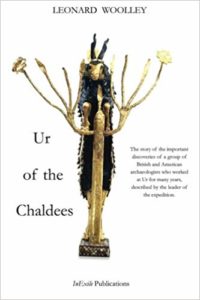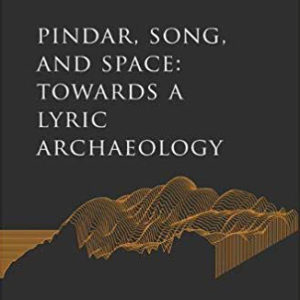by Billie Melman
The essay begins:
 No one could have grasped the relationship between the discovery of civilizations of the remote past, the visualization of their antiquity, and modernity better than Charles Leonard Woolley. One of the most eminent archaeologists of the first half of the twentieth century, Woolley was a doyen of Near-Eastern ancient history, a manipulator of newly developed media, and a celebrity, who noted that “an appeal to the eye is the best way of awakening interest in a new form of knowledge” (that is, archaeology). His observation about the accessibility to mass audiences of a past that had hitherto been largely known only through texts, that had barely existed as a materiality, and that had to be literally dug up to be envisioned, is to be found in his popular manual, Digging Up the Past, which was based on a series of six talks broadcast on the BBC and first published in 1930. By that time Woolley had already written Ur of the Chaldees, which aimed at a popular reading public; had begun publishing the multivolume Excavations at Ur, for professionals; had regularly contributed to the British and North American press; and had toured Britain. As numerous British and American reviewers of the booklet remarked, it proved that archaeology “concerned everyone. Its subject is modern man.”
No one could have grasped the relationship between the discovery of civilizations of the remote past, the visualization of their antiquity, and modernity better than Charles Leonard Woolley. One of the most eminent archaeologists of the first half of the twentieth century, Woolley was a doyen of Near-Eastern ancient history, a manipulator of newly developed media, and a celebrity, who noted that “an appeal to the eye is the best way of awakening interest in a new form of knowledge” (that is, archaeology). His observation about the accessibility to mass audiences of a past that had hitherto been largely known only through texts, that had barely existed as a materiality, and that had to be literally dug up to be envisioned, is to be found in his popular manual, Digging Up the Past, which was based on a series of six talks broadcast on the BBC and first published in 1930. By that time Woolley had already written Ur of the Chaldees, which aimed at a popular reading public; had begun publishing the multivolume Excavations at Ur, for professionals; had regularly contributed to the British and North American press; and had toured Britain. As numerous British and American reviewers of the booklet remarked, it proved that archaeology “concerned everyone. Its subject is modern man.”
By 1930 Woolley had acquired a public presence and his imperial persona was that of both a discoverer of the material cultures of ancient Mesopotamia and representative of the British Museum working in a territory that was now, after the First World War, part of a new Middle-Eastern imperial order. His observation highlights a web that connected modern empires, the visions of the past that had evolved in them, the forms and technologies of the visual, and the era historians have come to designate “late modernity.” Of course visual representations and spectacles of antiquity and their consumption evolved before late modernity and the beginning of the twentieth century. As far back as antiquity itself, the Greeks and Romans were displaying ancient Egyptian monuments, which again became popular during the Renaissance, and throughout the eighteenth and long nineteenth centuries Egyptomania has had multiple incarnations. In Britain, North America, and France a craze for the Assyrian Empire followed the discovery of its material civilizations in the 1840s and 1850s. As Gábor Klaniczay and Michael Werner have observed, “multiple antiquities”—that is, numerous and sometimes contradictory images and representations of the ancient past—have evolved in “multiple modernities” in order to mobilize the ancient world for national and imperial ends.
Between the outbreak of the First World War and the end of the Second, antiquity was reconceived and redefined in substantive and temporal terms; it was experienced and represented in new ways by international organizations, colonial administrators, archaeologists, and travelers. New forms, repertoires, and technologies of visualizing the distant past developed in tandem with new meanings of “the ancient” and particularly of “antiquities,” which at the time acquired unified legal definitions that were articulated in an international complex of agreements, institutions, and practices. The access of experts and varied publics to the remote past embodied in such antiquities was regulated by new colonial administrative apparatuses and mechanisms that monitored the study of ancient history; the circulation of knowledge about it; and the exposure, preservation, and display of its physical remains. Moreover, during this period, representation and display of the ancient past, how it was experienced—not least the manner and conditions under which it was actually seen—were dramatically affected by globalized technologies of transport and communication. These ranged from a commercially realigned press to new technologies of transport and documentation that combined speed and surveying capabilities, such as mechanized desert travel and aviation, particularly aerial photography.
This complex of definitions, representations, and displays of the remote past and the technologies implemented to discover it developed in a new world order, an order formulated in the peace treaties and agreements following the First World War whose crux was a new imperial regime based upon the mandates system. This system, based on hierarchical civilizational notions and the idea of rule as guardianship under international oversight, evolved in the territories that passed from the empires that had lost the war to its victors, mainly Britain (and its settler territories) and France. Within the mandate empires it was the Near-Eastern territories of the Ottoman Empire, now Class A mandates, ruled by the two victors under the League of Nations’ oversight, that became the crucible of what League of Nations’ internationalists described as “the new regime of antiquities.”
As historians of visual imperial cultures have noted, the study of empires and colonialism is still largely separate from studies of their visualization and display. To be sure, a number of art and cultural historians have repeatedly noted the imperial aspects of visual cultures, notably of British and French cultures but also of German and Ottoman. But these historians have focused mainly on the long nineteenth century. Moreover, studies of the orientalist recovery of an ancient Near-Eastern past have been somewhat narrowly compartmentalized, usually emphasizing just one aspect, such as literature, painting, cartography, museums, colonial expositions, or the theater. Such studies have been somewhat cut off from research on fields of inquiry that emerged and expanded during the long nineteenth century and the first half of the twentieth and produced knowledge about antiquity itself—from Assyriology and Egyptology to physical anthropology, paleontology, and geology, all of which offered historical narratives and analyses that were based on the practice of excavation. But most important, the study of new forms of looking at the remote past, despite its increasing attention to colonialism, has been largely shaped by a certain “methodological nationalism,” placing imperial visual culture within national frameworks. The nation or national state, whether it was the imperial state controlling colonial territories or the fledgling anticolonial national movements that emerged in India, Egypt, Iraq, and elsewhere, served historians of nationalism and archaeology, as well as art, not only as a thematic and geographical unit but also as an analytical tool to explain continuities and change in attitudes to the past.
My focus on the mandates era and the new interwar imperial order proposes an “entangled” visual history. Empires, and particularly modern empires, were characterized by the movement of people, goods, ideas and knowledge—and, we should add, by the circulation of objects, images, and repertoires of recounting and viewing the past. I propose to look at the interwar complex of the modern culture of antiquity from the metropolitan perspective, that of international institutions and organizations regulating excavation and exposure of antiquities to users and consumers throughout the British Empire and, finally, from the ground and even underground level—that is, from beneath the surface of excavation sites, the excavators’ point of view. Continue reading …
In this article historian Billie Melman explores the multiple visual presences of antiquity in the first half of the twentieth century and connects visual histories to the history of empires. She shows how archaeology mediated between the newly discovered material civilizations of the ancient Mesopotamian empires and experiences of modernity in the British Empire. Focusing on the spectacular archaeological discoveries at Ur, Tell Al-Muqayyar, in Southern Iraq, Melman demonstrates how the materiality of antiquity enabled its visualization in a variety of forms, from illustrations through photography and three-dimensional museum reconstructions.
 BILLIE MELMAN is Professor of Modern History at Tel Aviv University. She has written extensively on colonialism and culture, orientalism, and cross-cultural relations in the age of modern empires. She is completing a book on modernity, the rediscovery of antiquity, and imperial crisis during the first half of the twentieth century.
BILLIE MELMAN is Professor of Modern History at Tel Aviv University. She has written extensively on colonialism and culture, orientalism, and cross-cultural relations in the age of modern empires. She is completing a book on modernity, the rediscovery of antiquity, and imperial crisis during the first half of the twentieth century.


 No one could have grasped the relationship between the discovery of civilizations of the remote past, the visualization of their antiquity, and modernity better than Charles Leonard Woolley. One of the most eminent archaeologists of the first half of the twentieth century, Woolley was a doyen of Near-Eastern ancient history, a manipulator of newly developed media, and a celebrity, who noted that “an appeal to the eye is the best way of awakening interest in a new form of knowledge” (that is, archaeology). His observation about the accessibility to mass audiences of a past that had hitherto been largely known only through texts, that had barely existed as a materiality, and that had to be literally dug up to be envisioned, is to be found in his popular manual, Digging Up the Past, which was based on a series of six talks broadcast on the BBC and first published in 1930. By that time Woolley had already written Ur of the Chaldees, which aimed at a popular reading public; had begun publishing the multivolume Excavations at Ur, for professionals; had regularly contributed to the British and North American press; and had toured Britain. As numerous British and American reviewers of the booklet remarked, it proved that archaeology “concerned everyone. Its subject is modern man.”
No one could have grasped the relationship between the discovery of civilizations of the remote past, the visualization of their antiquity, and modernity better than Charles Leonard Woolley. One of the most eminent archaeologists of the first half of the twentieth century, Woolley was a doyen of Near-Eastern ancient history, a manipulator of newly developed media, and a celebrity, who noted that “an appeal to the eye is the best way of awakening interest in a new form of knowledge” (that is, archaeology). His observation about the accessibility to mass audiences of a past that had hitherto been largely known only through texts, that had barely existed as a materiality, and that had to be literally dug up to be envisioned, is to be found in his popular manual, Digging Up the Past, which was based on a series of six talks broadcast on the BBC and first published in 1930. By that time Woolley had already written Ur of the Chaldees, which aimed at a popular reading public; had begun publishing the multivolume Excavations at Ur, for professionals; had regularly contributed to the British and North American press; and had toured Britain. As numerous British and American reviewers of the booklet remarked, it proved that archaeology “concerned everyone. Its subject is modern man.”
